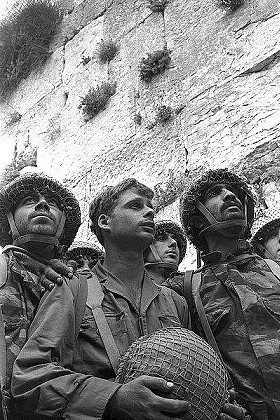Paying the price for a tragic Israeli surrender
On June 7, 1967, during Israel’s Six-Day War, Israeli Defense Forces Commander Mordechai Gur led the breakthrough in Jordanian defenses in Jerusalem and excitedly proclaimed: “The Temple Mount is in our hands.” It marked the first time that the Jewish people controlled Judaism’s holiest site in more than 2,000 years. Chief Rabbi Shlomo Goren blew his shofar in celebration and recited the Shehecheyanu prayer of thanksgiving. Army Chief of Staff Yitzhak Rabin sensed that he was “standing at the very heart of Jewish history.”
But the euphoria was short-lived. The current issue of Commentary features an illuminating (and sorrowful) article by Rabbi Meir Y. Soloveichik titled “Moshe Dayan’s Tragic Blunder.” He is referring to Israeli Defense Minister Dayan’s decision, at the moment of Israel’s triumphant victory, to prohibit Jews from praying on the Temple Mount, identified by Rabbi Soloveichik as “the most important site in Jewish history.”
Dayan, of course, knew this. Arriving at the Western Wall to greet triumphant Israeli soldiers, he proclaimed: “We have returned to our holiest site so as never to part with it again.” He added: “We did not come to conquer the holy sites of others or to restrict their religious rights.” Only the rights of Jews would be restricted — by Dayan himself.
At Dayan’s command, an Israeli flag raised over the Dome of the Rock on the Temple Mount to celebrate the victory was removed. Ten days later, meeting with Arab religious leaders at Al-Aqsa Mosque, he assured them that Muslims would decide who could enter and pray there. Their decision was predictable: Jews were prohibited.
The Western Wall below the mount was as close as Jews could get to the site of their ancient temples. In a stunning irony, they were forbidden by an Israeli military commander to pray at the holiest Jewish site.
Dayan’s decision, according to Erik Freas, author of “Nationalism and the Haram Al-Sharif/Temple Mount,” reflected “an essentially secular understanding of Jewish identity.” Indeed, Dayan had vacillated over whether the Temple Mount should even be in Israeli hands, asking sardonically: “What do I need all this Vatican for?”
Despite Gur’s assurance that the Temple Mount was “in our hands,” it was not. The Israeli government, fearful that it would provoke heightened conflict with Arab states, agreed. The Kingdom of Jordan, not the State of Israel, would control the most sacred Jewish site. Ironically, Israeli chief rabbis expressed pleasure that the mount was under Jewish control but warned Jews not to go there. Israel would retain the Mount, but Muslims would rule over it.
A similar Israeli surrender occurred in Hebron, where another stunning victory in the Six-Day War returned the most ancient holy city and sites to the Jewish people. For millennia, the Machpelah burial place of the biblical patriarchs and matriarchs had been closed to Jews by Muslim rulers.
But Dayan, once again, intervened. He countermanded Goren’s attempts to reclaim Machpelah for Israel and Judaism. To placate Arab Muslims, he ordered the Israeli flag lowered and a Torah scroll removed.
Visiting hours for Jews were restricted; no Jewish worship was allowed on Fridays, Islam’s Sabbath. When Goren gave permission for wedding ceremonies to be held inside Machpelah, Dayan overruled him. It was, Dayan subsequently wrote, “up to us to show broad tolerance.” No such tolerance was extended to religious Jews.
Dayan’s decision to prohibit Jewish prayer on the Temple Mount, writes Rabbi Soloveichik, “was a terrible mistake, the worst in Israel’s history.” It “was founded on total disregard for what the Temple Mount meant to religious Jews.”
Two years ago, an Israeli rabbi was removed from the Temple Mount for praying there — silently — during his Yom Kippur visit. But his appeal was upheld by a judge, who noted that “his prayer was quiet, whispered.” Only Muslims, it seems, can pray loudly at the holiest Jewish site.







